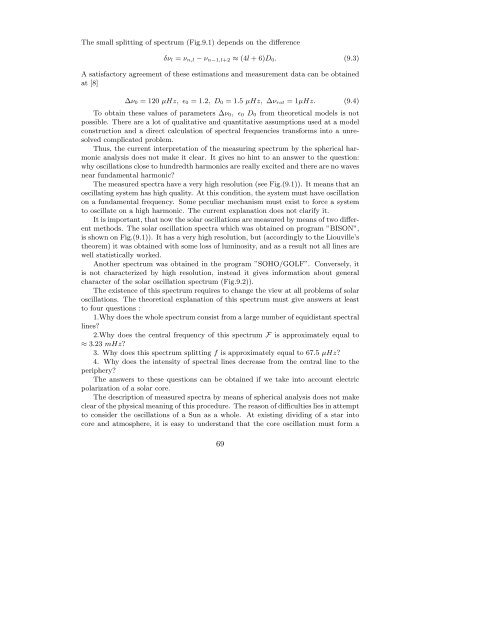VbvAstE-001
Book Boris V. Vasiliev Astrophysics
Book Boris V. Vasiliev
Astrophysics
You also want an ePaper? Increase the reach of your titles
YUMPU automatically turns print PDFs into web optimized ePapers that Google loves.
The small splitting of spectrum (Fig.9.1) depends on the difference<br />
δν l = ν n,l − ν n−1,l+2 ≈ (4l + 6)D 0. (9.3)<br />
A satisfactory agreement of these estimations and measurement data can be obtained<br />
at [8]<br />
∆ν 0 = 120 µHz, ɛ 0 = 1.2, D 0 = 1.5 µHz, ∆ν rot = 1µHz. (9.4)<br />
To obtain these values of parameters ∆ν 0, ɛ 0 D 0 from theoretical models is not<br />
possible. There are a lot of qualitative and quantitative assumptions used at a model<br />
construction and a direct calculation of spectral frequencies transforms into a unresolved<br />
complicated problem.<br />
Thus, the current interpretation of the measuring spectrum by the spherical harmonic<br />
analysis does not make it clear. It gives no hint to an answer to the question:<br />
why oscillations close to hundredth harmonics are really excited and there are no waves<br />
near fundamental harmonic?<br />
The measured spectra have a very high resolution (see Fig.(9.1)). It means that an<br />
oscillating system has high quality. At this condition, the system must have oscillation<br />
on a fundamental frequency. Some peculiar mechanism must exist to force a system<br />
to oscillate on a high harmonic. The current explanation does not clarify it.<br />
It is important, that now the solar oscillations are measured by means of two different<br />
methods. The solar oscillation spectra which was obtained on program ”BISON”,<br />
is shown on Fig.(9.1)). It has a very high resolution, but (accordingly to the Liouville’s<br />
theorem) it was obtained with some loss of luminosity, and as a result not all lines are<br />
well statistically worked.<br />
Another spectrum was obtained in the program ”SOHO/GOLF”. Conversely, it<br />
is not characterized by high resolution, instead it gives information about general<br />
character of the solar oscillation spectrum (Fig.9.2)).<br />
The existence of this spectrum requires to change the view at all problems of solar<br />
oscillations. The theoretical explanation of this spectrum must give answers at least<br />
to four questions :<br />
1.Why does the whole spectrum consist from a large number of equidistant spectral<br />
lines?<br />
2.Why does the central frequency of this spectrum F is approximately equal to<br />
≈ 3.23 mHz?<br />
3. Why does this spectrum splitting f is approximately equal to 67.5 µHz?<br />
4. Why does the intensity of spectral lines decrease from the central line to the<br />
periphery?<br />
The answers to these questions can be obtained if we take into account electric<br />
polarization of a solar core.<br />
The description of measured spectra by means of spherical analysis does not make<br />
clear of the physical meaning of this procedure. The reason of difficulties lies in attempt<br />
to consider the oscillations of a Sun as a whole. At existing dividing of a star into<br />
core and atmosphere, it is easy to understand that the core oscillation must form a<br />
69













